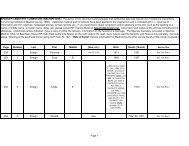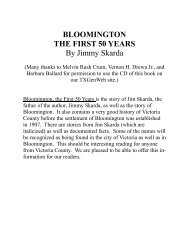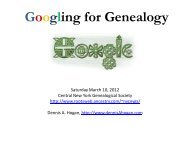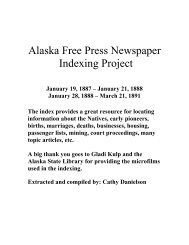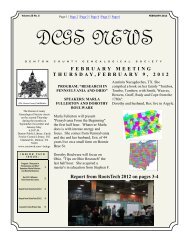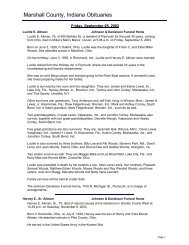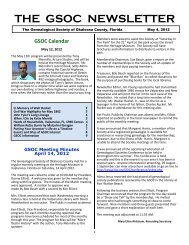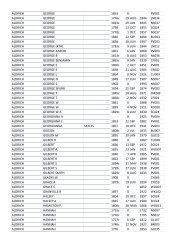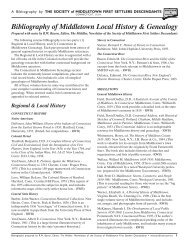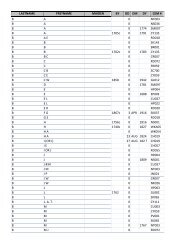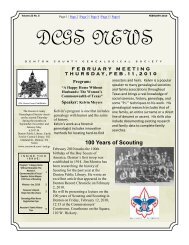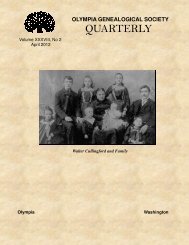Indian population in the United States and Alaska. 1910 - RootsWeb
Indian population in the United States and Alaska. 1910 - RootsWeb
Indian population in the United States and Alaska. 1910 - RootsWeb
Create successful ePaper yourself
Turn your PDF publications into a flip-book with our unique Google optimized e-Paper software.
STOCKS AND TRIBES, BY SEX, AGE, AND BLOOD. Ill<br />
MISCELLANEOUS<br />
There were 1,644 persons returned on <strong>the</strong> special<br />
<strong>Indian</strong>, schedule for whom <strong>the</strong> stock or tribe was not<br />
reported, or for whom <strong>the</strong> return was too <strong>in</strong>def<strong>in</strong>ite to<br />
admit of classifi.cation. These returns were as follows:<br />
Sixteen were reported as hav<strong>in</strong>g come from <strong>Alaska</strong>,<br />
<strong>and</strong> were distributed among <strong>the</strong> states, as follows:<br />
Oregon, 7; Pennsylvania, 6; Wash<strong>in</strong>gton, 2; North<br />
Dakota, 1.<br />
One hundred <strong>and</strong> twenty-two were reported as<br />
hav<strong>in</strong>g come from California.<br />
Two hundred <strong>and</strong> twenty-eight were returned as<br />
"Cupeno," a name given to <strong>the</strong> former occupants of<br />
<strong>the</strong> village of Cupa or Gupa, now located ma<strong>in</strong>ly at<br />
Pala, San Diego County, Cal. They were <strong>in</strong> all<br />
probability Shoshonean (Luiseno), but ow<strong>in</strong>g to <strong>the</strong><br />
iaclusion of some Diegueno <strong>the</strong>y are not here <strong>in</strong>cluded<br />
under any stock.<br />
Fifteen were reported as "Digger," a name long<br />
used popularly for a large number of different <strong>Indian</strong><br />
tribes of California, Oregon, Nevada, <strong>and</strong> <strong>the</strong> whole<br />
of <strong>the</strong> <strong>in</strong>terior plateau region. The name has no<br />
value <strong>and</strong> is very confus<strong>in</strong>g. Special <strong>in</strong>structions<br />
were given to enumerators not to use <strong>the</strong> name,<br />
never<strong>the</strong>less 12 were reported from Pennsylvania,<br />
2 from Nevada, <strong>and</strong> 1 from Utah. It was not pos-<br />
sible to assign <strong>the</strong>m to any def<strong>in</strong>ite tribe or stock.<br />
Twenty-seven were returned simply as "Mission<br />
<strong>Indian</strong>s," a general term applied to all <strong>the</strong> coastal<br />
<strong>Indian</strong>s of sou<strong>the</strong>rn California <strong>and</strong> which gives no<br />
<strong>in</strong>dication of tribal or stock affiHation. They were<br />
ALGONQULAN STOCK.<br />
Three members of this stock (see p. 72) belong<strong>in</strong>g to<br />
<strong>the</strong> Delaware tribe were enumerated <strong>in</strong> <strong>Alaska</strong> <strong>in</strong><br />
<strong>1910</strong>—2 males, 1 of fuU blood <strong>and</strong> 1 of mixed blood,<br />
<strong>and</strong> 1 mixed-blood female.<br />
ATHAPASKAN STOCK.<br />
Stock as a whole.—One of <strong>the</strong> largest of <strong>the</strong> stocks<br />
<strong>in</strong> North America, tribes belong<strong>in</strong>g to it be<strong>in</strong>g found<br />
from near <strong>the</strong> Arctic coast to <strong>the</strong> Mexican boundary<br />
(see also p. 77). The area occupied by <strong>the</strong> nor<strong>the</strong>rn<br />
<strong>and</strong> territorially largest portion of <strong>the</strong> stock may be<br />
described <strong>in</strong> general as <strong>in</strong>clud<strong>in</strong>g <strong>the</strong> whole <strong>in</strong>terior of<br />
<strong>Alaska</strong> <strong>and</strong> nor<strong>the</strong>rn British Columbia, <strong>and</strong> <strong>the</strong> whole<br />
of <strong>the</strong> Canadian territories of Yukon, Mackenzie, <strong>and</strong><br />
Athabasca. The tribal divisions are somewhat un-<br />
certa<strong>in</strong>. The <strong>Indian</strong>s of <strong>the</strong> Athapaskan stock <strong>in</strong><br />
<strong>Alaska</strong>, as enumerated <strong>in</strong> <strong>1910</strong>, numbered 3,916.<br />
.<br />
INDIANS IN ALASKA.<br />
The<br />
tribes of this stock, for which members were reported<br />
<strong>in</strong> <strong>Alaska</strong>, are as follows:<br />
Ahtena. Kutch<strong>in</strong>. Tukkuthkutch<strong>in</strong>.<br />
Hankutch<strong>in</strong>. Nahane. Unakhotana.<br />
Kaiyuhkhotana. Nataitkutch<strong>in</strong>. Vuntakutcliiii.<br />
Knaiakhotana. Tenankutch<strong>in</strong>.<br />
probably Shoshonean or Yuman. They were mostly<br />
<strong>Indian</strong> children at school <strong>and</strong> were distributed among<br />
<strong>the</strong> states, as follows: Arizona, 10; Pennsylvania, 7;<br />
Kansas, 5; California, 3; Oregon, 2.<br />
Four <strong>Indian</strong>s were returned as "Oswego." It ia<br />
uncerta<strong>in</strong> what was meant by this name, but it is<br />
probable that <strong>the</strong>se were Osw<strong>in</strong>go or Chenango, <strong>the</strong><br />
name by which a portion of <strong>the</strong> Nanticoke of Maryl<strong>and</strong><br />
were known from <strong>the</strong>ir settl<strong>in</strong>g at Chenango,<br />
N. Y., <strong>in</strong> <strong>the</strong> middle of <strong>the</strong> eighteenth century. They<br />
later joiaed <strong>the</strong> Delaware <strong>and</strong> probably moved West<br />
with <strong>the</strong>m.<br />
One hundred <strong>and</strong> eighteen <strong>Indian</strong>s were returned<br />
as "Pueblo" without dist<strong>in</strong>ction as to <strong>the</strong> particular<br />
pueblo to which <strong>the</strong>y belonged, <strong>and</strong> it was <strong>the</strong>refore<br />
impossible to aflSliate <strong>the</strong>m with <strong>the</strong>ir proper stock.<br />
The majority were ei<strong>the</strong>r Tanoan or Keresan, <strong>and</strong> a<br />
few probably Hopi. Most of <strong>the</strong>m were pupils at<br />
<strong>Indian</strong> schools <strong>and</strong> were distributed among <strong>the</strong> states,<br />
as follows: 36 <strong>in</strong> Kansas, 29 <strong>in</strong> Pennsylvania, 20 <strong>in</strong><br />
Arizona, 17 <strong>in</strong> California, 7 <strong>in</strong> Oklahoma, 5 <strong>in</strong> New<br />
Mexico, <strong>and</strong> 1 each <strong>in</strong> Colorado, North Carol<strong>in</strong>a,<br />
Oregon, <strong>and</strong> South Dakota.<br />
Twelve <strong>Indian</strong>s were returned as "Redwood," a<br />
name used locally <strong>in</strong> California for two different<br />
tribes—<strong>the</strong> Huchnom, a YuMan tribe, <strong>and</strong> <strong>the</strong><br />
Whilkut, an Athapaskan tribe. They could not,<br />
<strong>the</strong>refore, be counted with ei<strong>the</strong>r. Of <strong>the</strong>m, 11 were<br />
<strong>in</strong> California <strong>and</strong> 1 <strong>in</strong> Kansas.<br />
In addition to <strong>the</strong> above, 1,102 <strong>Indian</strong>s were reported<br />
on <strong>the</strong> schedule with <strong>the</strong> stock <strong>and</strong> tribe<br />
simply as "unknown."<br />
Comparison with census figures for previous years is<br />
of doubtful value, as <strong>the</strong>se were, ow<strong>in</strong>g to <strong>the</strong> unex-<br />
plored character of <strong>the</strong> country, to a considerable<br />
extent estimates. The number reported at <strong>the</strong> census<br />
of 1890 was 3,520 <strong>and</strong> that of 1880 was 4,057.<br />
Ahtena.—^A tribe occupy<strong>in</strong>g <strong>the</strong> bas<strong>in</strong> of <strong>the</strong> Copper<br />
River. The number enumerated <strong>in</strong> <strong>1910</strong> was 297.<br />
The census of 1890 gave <strong>the</strong> number of this tribe as<br />
150, but at <strong>the</strong> census of 1880 it was reported as 250.<br />
HanTcutch<strong>in</strong>.—A tribe belong<strong>in</strong>g to <strong>the</strong> Kutch<strong>in</strong><br />
division of this stock, <strong>and</strong> occupy<strong>in</strong>g <strong>the</strong> region along<br />
<strong>the</strong> Yukon River for 50 or 75 nules above <strong>and</strong> below<br />
<strong>the</strong> <strong>in</strong>ternational boundary. The number enumerated<br />
<strong>in</strong> <strong>1910</strong> was 127. The census of 1880 reported 106,<br />
but it is probable that <strong>the</strong> returns were <strong>in</strong>complete.<br />
KaiyuhJchotana.—^A tribe occupy<strong>in</strong>g <strong>the</strong> region along<br />
<strong>the</strong> Yukon River between <strong>the</strong> Anvik <strong>and</strong> Koyukuk<br />
Rivers, <strong>and</strong> for some distance east <strong>and</strong> south toward<br />
<strong>the</strong> Kuskokwim River. The number enumerated <strong>in</strong><br />
<strong>1910</strong> was 160. Ow<strong>in</strong>g to some uncerta<strong>in</strong>ty <strong>in</strong> <strong>the</strong><br />
application of <strong>the</strong> name, comparison with <strong>the</strong> census<br />
figures of earlier years is of Uttle value. In 1890 <strong>the</strong><br />
number reported was 1,140. In 1880 <strong>the</strong> census figure<br />
was 1,222 <strong>and</strong> that of <strong>the</strong> Bureau of American Ethnology<br />
953.



